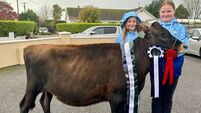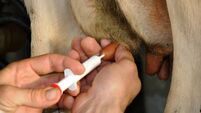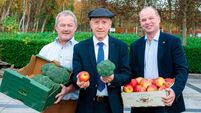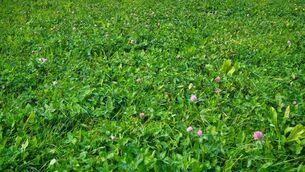Paula Hynes: We need to work together to eradicate TB
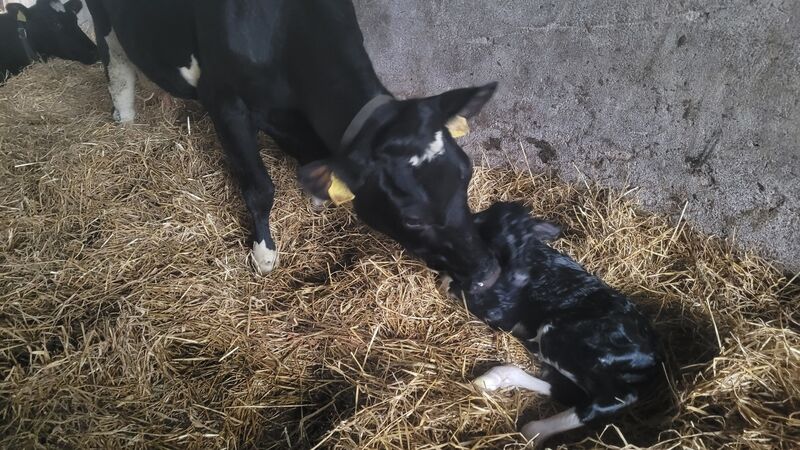
Rathard Blossom recently calved on the Hynes farm, dam of one of the top 5% TB resistant bulls in Ireland
We had our annual herd TB test last week. It is not an easy task in the middle of calving season, but at least with the bulk of calving complete, there were a lot fewer heavily pregnant cows to put through the crush.
It is always a stressful occasion for the cows as it is outside of their normal routine, but the only way to approach it is to take time with the cows so as to limit the stress.
With so many farms going down with TB across Ireland, it makes it an anxious time as the repercussions of being locked up with TB are huge for a farmer, and it would take a minimum of six months before a farm could sell livestock again, provided they had two 60-day clear tests.
As the day of reading the TB test arrived, there was a nervous vibe around the yard. Thankfully, the test was very clean, so we are clear for another year, before having to do some movement testing of show animals later in the year.
Until we have a clear annual TB test, we can’t even plan our show season, as farms that are locked up with TB cannot compete at agricultural shows.
We are 11 years clear of TB now, and when I think back to when we had the last breakdown, I am very grateful to the two Department of Agriculture vets who worked with us and advised us at the time.
We analysed the parentage of the TB reactors at the time and realised they all stemmed from four cow families, so, at the time, any remaining members of those cow families were blood tested, which is a longer process of TB testing, and more were identified as TB reactors.
We are also part of the Department of Agriculture wildlife control programme and have a fantastic team that monitors the farm every year under license for badger activity.
The reality is to control TB in livestock, it must also be controlled in wildlife as well, and both badgers and deer can carry TB.
I know there are some who might be against controlling the population of deer and badgers in the country, but realistically, there is no point in having a large population of wildlife which are rampant with TB and simply allowed to die a miserable death — surely it is better practice to kill them humanely.
The population of deer is far too high in many areas and if you ask any skilled deer hunter, they will tell you TB is rampant among the deer population.
In the last 12 months, there were over 6,000 herds restricted with TB in Ireland, which is an incidence rate of more than 6% — some try to lay the high incidence rate on the Department of Agriculture.
However, I don’t know a single Department of Agriculture vet who would wish TB on a farm. They are highly aware of the devastating consequences it has for farms and farm families, and the only way we are really going to tackle this disease is by working together. There are many things we, as farmers, can do on farms.
Water troughs need to be high to eliminate badgers from having access to them — if the badger can treat a cow's water trough as a wildlife jacuzzi, then it can lead to trouble.
Feed needs to be stored in areas to lessen the temptation for wildlife. Badgers love sugar beet, and if it is stored in a really quiet part of the farm yard, any local badger will surely pay it a visit at night for a sugary snack. Badgers actually try to avoid cows, so if the beet is stored as close to the herd as possible, it will be safer.
We know where the main set is on our farm, and we notify the Department of Agriculture if we see any new activity and while the set is fenced off. We also use a strip wire to put an extra semi-circle boundary around the set, ensuring the cows can never sniff or access any fresh earth of badger droppings — if you look at a badger set, they will always poop outside.
I mentioned our last TB breakdown was connected to four cow families, some bovines have a greater resistance to TB and we as famers can continue to breed TB resistance into a herd. Looking at our ICBF profile recently, I noticed our EBI profile now also shows the TB PTA as one of the main indexes.
We have been placing more emphasis on our herd's health indexes when we are breeding replacements. To improve TB resistance, farmers should choose bulls with a PTA value of less than 8%, and to really drive resistance forward, choose bulls with a value below 6.5%. High EBI does not guarantee TB resistance — you have to look at the individual PTA for TB resistance in bulls.
For farms that purchase replacements, it is important to know the TB history of a farm — this information is accessible on Agfood so it is important we get into the habit of asking the source herd for this information.
We often sell heifers and are always asked about the vaccination programme on the farm, but we have yet to be asked how many years the farm is clear of TB.
I’m not sure if I will see TB eradicated from Irish farms in my lifetime, but I know we will get a lot closer to eradication if we all work together.



